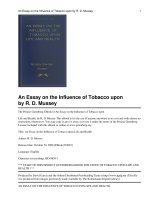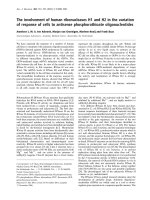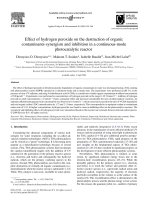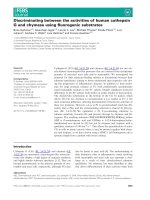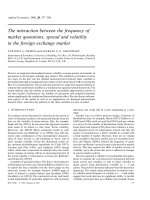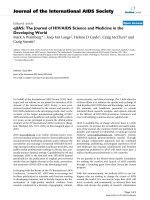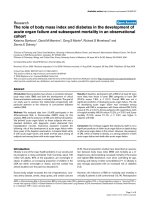- Trang chủ >>
- Khoa Học Tự Nhiên >>
- Vật lý
the biology of human survival life and death in extreme environments sep 2003
Bạn đang xem bản rút gọn của tài liệu. Xem và tải ngay bản đầy đủ của tài liệu tại đây (4.23 MB, 280 trang )
The Biology of
Human Survival:
Life and Death in
Extreme Environments
CLAUDE A. PIANTADOSI, M.D.
OXFORD UNIVERSITY PRESS
The Biology of Human Survival
This page intentionally left blank
The
BIOLOGY
of
HUMAN
SURVIVAL
Life and Death in
Extreme Environments
CLAUDE A. PIANTADOSI, M.D.
Center for Hyperbaric Medicine and Environmental Physiology
Duke University Medical Center
Durham, North Carolina
1
2003
3
Oxford New York
Auckland Bangkok Buenos Aires Cape Town Chennai
Dar es Salaam Delhi Hong Kong Istanbul Karachi Kolkata
Kuala Lumpur Madrid Melbourne Mexico City Mumbai
Nairobi São Paulo Shanghai Taipei Tokyo Toronto
Copyright © 2003 by Oxford University Press, Inc.
Published by Oxford University Press, Inc.
198 Madison Avenue, New York, New York, 10016
www.oup-usa.org
Oxford is a registered trademark of Oxford University Press
All rights reserved. No part of this publication may be reproduced,
stored in a retrieval system, or transmitted, in any form or by any means,
electronic, mechanical, photocopying, recording, or otherwise,
without the prior permission of Oxford University Press.
Library of Congress Cataloging-in-Publication Data
Piantadosi, Claude A.
The biology of human survival : life and death in extreme environments /
Claude A. Piantadosi.
p. cm. Includes bibliographical references and index:
ISBN 0-19-516501-2
1. Extreme environments. 2. Adaptation (Biology)
3. Human physiology. I. Title.
QP82.P536 2003 612—dc21 2003040497
987654321
Printed in the United States of America
on acid-free paper
Adapt or perish, now as ever, is nature’s inexorable imperative.
—H.G. Wells
This page intentionally left blank
To persevere across far-ranging environments is profoundly human, but life at
the extremes is constrained in extraordinary ways. The diversity of environments
in which people are found, either as permanent inhabitants or as temporary visi-
tors, ranges from the high Andes to the scorched Sahara to the frigid Arctic, yet
these places are a small fraction of those that harbor life in the thin biosphere around
the planet’s surface. Most of Earth is too inhospitable for even optimally adapted
individuals, and out of necessity, curiosity, or self-indulgence, we have invented
technologies to venture into previously impenetrable domains, from the depths
of the oceans to the depths of space.
Humans on the frontiers of exploration are tested to the limits of their lives.
The Biology of Human Survival pinpoints critical factors that dictate life or death
at the utmost reaches, including those places accessible to humans only with life-
support technology. The book presents environmental physiology using modern,
integrated concepts of stress, tolerance, and adaptation. Barriers to life in extreme
environments, such as dehydration, starvation, and radiation, are described in
separate chapters. Other chapters explain the problems unique to specific envi-
ronments by examining the determinants of an individual’s survival at extremes
of cold, heat, altitude, or immersion. Key issues in these specialized settings are
illustrated with examples of extreme hardship from great exploits that have at-
tracted people’s attention throughout history.
Preface
For each environment the book asks these central questions: How does the
human body respond to the change in environment and what happens when adap-
tive mechanisms fail? When does biology reach its limits and when must technol-
ogy take over? How do scientists evaluate the biological responses to extreme states
and solve life-support problems under such conditions? These intriguing ques-
tions and their implications offer a fresh look at the human condition.
The book reveals the intricacy with which the human body responds and adapts
to environmental change and reminds us that physics and biology collide head-
on at many levels, which leads to multiple stresses and numerous opportunities
to counter them. As implied by the common etymology of the words physics
and physiology, it is physics that limits life. The physics needed to understand
these limitations is explained in language that will be meaningful to students of
biology at all levels.
Despite the great heterogeneity of environmental stimuli, all stresses evoke cer-
tain common responses. These have been organized in the book to unify general
survival principles with mechanisms of adaptation to specific environments. The
overarching principles are the body’s recognition of stress and the brain’s control
of physiological systems in order to optimize cardiovascular, respiratory, renal,
and hormonal performance. These adjustments conserve and manage vital body
resources, such as water, salt, and heat and provide time for the individual to escape
or for the body’s molecular machinery to adapt.
Probing common reactions to different stresses also provides an opportunity
to point out unique stress responses and ingenious solutions to living in mar-
ginal environments found throughout the animal kingdom. This allows one to
better appreciate why specific functions must be supported in specific environ-
ments by man-made devices. Accordingly, the biology in this book is appropri-
ate for engineers and physical scientists as well as any intelligent explorer of
the natural world.
The struggle between organism and environment is nature’s paradigm, but this
is often underplayed in human endeavors. We consider ourselves separate from
other animals because we adapt to new environments, in part, by rational action.
Thus, the book’s underlying theme is the role of behavior in adaptation, empha-
sizing circumstances in which human technology will forever change the envi-
ronment, such as after a nuclear war or during colonization of space. Once the
subtle interplay of environment with the body’s responses and the individual’s
behavior is grasped, a new window opens onto human survival.
The distinction between biology and behavior is somewhat artificial but con-
ceptually useful. Behavioral adaptation as embodied in modern technology has
eliminated most of the day-to-day pressures that molded our ancestors. Virtually
instantaneous access to resources such as food, water, shelter, power, medicine,
and transportation shape today’s individual as much or more than does biologica1
adaptation. The long-term implications of this shift in our way of life are not well
viii PREFACE
understood, and the book describes special environments, such as long voyages
in space, in which these unknowns may become especially important.
That environment shapes humanity is never at issue in the book. Rather, we,
more than any other species, stand to influence our destiny through our ability to
alter the natural world. The natural consequences of global environmental change
are familiar to all biologists, and ecological change that creates hardships over
which many individuals cannot prevail and multiply will extinguish whole species.
A famous example is the effect of the insecticide DDT on the loss of durability of
the eggshell of predatory birds, such as the bald eagle (Carson, 1963). Overuse of
DDT after World War II threatened their extinction by interfering with the birth-
rate of hatchlings, a problem that went uncorrected until long after DDT was
banned in the United States.
Our propensity to restructure our environment and, soon, our own biology has
fantastic implications for human survival that are touched on in the book. This
topic has caused theorists to argue over the process of human evolution; some
have even proclaimed its end. In any event, modifying the environment at the
expense of biological adaptability alters humanity’s evolutionary direction. A fore-
warning of what may await us lies in the fossil record of extinctions brought about
by radical fluctuations in climate, but whether change in our environment or our
biology is the more significant factor remains unknown.
These matters of “population biology” raise the issue of whether information
about our own biology can help us avoid extinction. Human intelligence brings
optimism to this prospect, but great cleverness is a double-edged sword that car-
ries the specter of self-annihilation. It is also true that knowledge of human biol-
ogy is progressing faster than is natural biology itself, but no matter how pleasing
the vision of mind over nature, it underestimates natural selection and the effect
of the unpredictable on human evolution.
The debate over human evolution is beyond the scope of the book, which deals
with the individual, for whom the outcome of environmental stress can be reduced
to tolerance and adaptation or death. These outcomes, however, have important
ramifications for the long-term survival of humans both on this planet and else-
where in the solar system. Thus, understanding how individuals adapt to the en-
vironment is a step on the road to discovering how the physical world shapes human
biology.
Durham, North Carolina C.A.P.
Preface ix
This page intentionally left blank
xi
1. The Human Environment, 1
The nature of human physical boundaries, 1
The importance of preparation for extreme exposures, 4
Some basic concepts of survival analysis, 5
Characteristics of life-support systems, 8
2. Survival and Adaptation, 10
The science of human physiology, 10
Principles of physiological regulation and adaptation, 13
Defining physiological adaptation to the environment, 16
Acclimatization and acclimation, 18
3. Cross-Acclimation, 21
The complexity of adaptation to environment, 21
Positive and negative cross-acclimation, 22
Biochemical mediators of physiological adaptation, 24
Stress proteins and the stress response, 25
4. Food for Thought, 29
A brief overview of human starvation, 29
Starvation: an affliction of the very young and the very old, 30
Assessing the severity of starvation, 31
Contents
xii CONTENTS
Why children die of starvation, 33
Other critical factors in human starvation, 34
Starvation and obesity: strange bedfellows, 36
The molecular basis of obesity and hunger, 38
5. Water and Salt, 41
The composition of body water, 42
Why do human food and water requirements differ? 43
The body’s minimum daily water requirements, 45
The mechanism of dehydration and the body’s responses, 47
Dehydration and heat tolerance, 49
Survival time without drinking water, 51
6. Water That Makes Men Mad, 54
The composition of seawater, 55
Ingestion of seawater, 55
Survival at sea, 56
Lessons from the USS Indianapolis, 57
A practical approach to salt and water loss at sea, 60
7. Tolerance to Heat, 63
Mammalian homeothermy, 63
Humans as tropical primates, 64
Body heat balance, 65
Heat acclimatization, 70
Heat acclimatization and physical fitness, 71
The limitations of human tolerance to heat, 72
Heat illnesses, 73
Death by heatstroke, 76
8. Endless Oceans of Sand, 78
The camel and the Berber, 79
Desert lessons from Pablo and the Haj, 83
Thermal stress and behavior, 84
Importance and regulation of heat-escape activities, 86
9. Hypothermia, 89
The effects of extreme cold on the extremities, 89
Settings for systemic hypothermia, 90
The physiology of hypothermia, 92
Unexpected effects of cold and hypothermia, 95
The subtle effect of winter on human mortality, 96
10. Life and Death on the Crystal Desert, 99
Life in Antarctica, 99
Contents xiii
The race for the South Pole, 100
Failure to adapt to Antarctic conditions, 104
Engineering out the need to tolerate cold, 106
Human acclimation to cold, 107
Estivation, 111
Hibernation, 112
Hibernation, energy conservation, and suspended animation, 117
11. Survival in Cold Water, 119
The sinking of the Titanic, 119
Water temperature and human survival, 121
Prediction of survival time in cold water, 121
Survival behavior in cold water, 123
Hypothermia in deep sea diving, 125
Respiratory heat losses and slow cooling, 127
12. Air as Good as We Deserve, 129
Life in an oxidizing atmosphere, 129
Biological oxidations and oxygen toxicity, 132
Antioxidant defenses and the oxidant–antioxidant balance, 135
The free radical theory of aging, 136
13. Bends and Rapture of the Deep, 140
Decompression sickness, 141
Rapture of the deep, 145
Pressure reversal of anesthesia and the high-pressure nervous syndrome, 148
Implications of high pressure for human life on other planets, 150
14. Sunken Submarines, 152
The sinking of the Kursk, 152
The debate over submarine escape, 155
The physics of submarine disasters, 156
Analysis of survival factors on sunken submarines, 158
15. Climbing Higher, 164
The physical environment of high altitude, 164
Physiological responses to high altitude, 166
High-altitude illnesses, 173
The zone of death, 176
Limits of human ascent to high altitude, 179
16. Into the Wild Blue Yonder, 181
The International Standard Atmosphere, 181
Human visitation to the stratosphere, 183
Depressurization accidents, 185
xiv CONTENTS
The Armstrong line, 188
The pressure suit, 189
17. G Whiz, 193
The continuity principle, 193
Gravity and acceleration, 194
High-G environments, 195
Limits of high-G tolerance, 197
Adaptation to sustained G forces, 201
18. The Gravity of Microgravity, 203
Space sickness, 204
Intolerance of upright posture, 204
Loss of bone mass in space, 206
Loss of muscle mass in space, 209
19. Weapons of Mass Destruction, 212
Biological and chemical warfare agents, 213
Thermonuclear weapons, 217
Types of radiation, 219
Biological effects of radiation, 220
Radiation and the human body, 223
20. Human Prospects for Colonizing Space, 227
Advanced life-support systems, 228
Mission to Mars, 230
Habitability factors in long-duration spaceflight, 232
Deleterious effects of long-term exposure to microgravity, 234
Effects of life in space on human immunity, 235
Long-term effects of radiation on human life in space, 238
Establishment of permanent human populations in space, 242
Bibliography and Supplemental Reading, 247
Index, 255
The Biology of Human Survival
This page intentionally left blank
1
The Human Environment
1
As with any other species, human survival boils down to individual survival. This
is true whether people die of disease, natural disaster, or manmade holocaust.
Fundamentally, survival can be defined in terms of the interactions between an
individual and its natural surroundings. The surroundings determine the extent to
which a person is exposed to critical changes in environment, such as tempera-
ture, water, food, or oxygen. The physical world imposes strict limits on human
biology, and learning where these limits are and how to deal with them is what
biologists call limit physiology. The principles of limit physiology can be applied
to understanding human life in all extreme environments. These principles will
be developed in this chapter and applied throughout the book to gain a deeper
appreciation of how humans survive in extreme conditions.
The Nature of Human Physical Boundaries
One of the most important characteristics of every living organism is its ability to
maintain an active equilibrium, however brief or delicate, with its natural envi-
ronment. All living beings, as integral parts of nature, can be characterized by the
dynamic exchange they maintain with their physical surroundings. Being alive
requires being attuned to natural change, and many organisms are exquisitely
2 THE BIOLOGY OF HUMAN SURVIVAL
sensitive to even tiny perturbations in environmental conditions. They occupy
restricted niches. If changes in conditions in the niche exceed certain limits, bio-
logical equilibrium is disrupted, and the life of the organism, or even the entire
species, is threatened. Thus, all habitable environments, or habitats, have specific
physical boundaries within which life is possible and outside which life is impos-
sible. As an organism approaches the limits of its habitat, life is sustainable only
with greater and greater effort unless the effort is sufficient for adaptation to occur.
Indeed, the closer the organism approaches a tolerance limit, and the greater the
stress, the more vigorous will be the attempt to compensate, and if it falls short,
the shorter will be the survival time. This principle is illustrated in Figure 1.1. The
curve has the shape of a rectangular hyperbola, which is characteristic of many
survival functions depicted throughout this book.
Human beings are among the most adaptable creatures on the planet, yet the lim-
its of human survival are astonishingly narrow when viewed in the context of the
extremes on the planet. Approximately two-thirds of the Earth’s surface is covered
by deep saltwater oceans, which air-breathing terrestrial mammals such as ourselves
may visit briefly but are not free to inhabit. Even highly specialized diving mam-
mals, the great cetaceans, so spectacularly adapted for life in the sea, are confined
to the surface layers of the ocean. The crushing pressure of the seawater, the cold,
and the darkness make the great depths of the ocean inhospitable to most marine
species. Not that life cannot exist or even thrive under such extremes, for even at
the bottom of the sea super-hot water jets heated by vents in the Earth’s mantle sup-
Figure 1.1. The relationship between the ability to compensate for and the severity of
physiological stress or strain. X-axis indicates time to failure of function, or, in the case of
survival, to death. The time scale may be in any unit, from seconds to days, depending on
the nature and intensity of the stress or strain. Adaptation shifts the position of the curve
to the right.
The Human Environment 3
port highly sophisticated and unique forms of life, but the thought of people exist-
ing permanently in such places is unimaginable. Many species that thrive in the depths
die when brought too quickly to the ocean’s surface.
Of the land that covers the remaining third of the Earth’s surface, one-fourth is
permanently frozen and one-fourth is arid desert; both are extremes that may be
inhabited by humans only with arduous efforts. Add to this the high mountain
ranges and the lakes and rivers that people depend on but do not routinely inhabit,
and the climate and topography temperate enough for permanent habitation by
humans relegates us to one-sixth of the surface of the planet. Despite the rich
diversity and capacity of people to respond, adapt, or acclimatize to extreme con-
ditions, the limits of human tolerance are remarkably narrow. Indeed, civilization’s
stamp has been its ability to extend an individual’s tolerance to stressful environ-
ments by making behavioral adaptations in the form of invention (Figure 1.2).
The environment of human beings is constrained geographically because lati-
tude and topography cause variations in temperature, barometric pressure, avail-
ability of food and water, and combinations of each that are critical for survival.
Thus, it is no surprise that much of the world’s population is perched on the brink
of disaster. The loss of human life from a sudden natural disaster such as a bliz-
zard or a flood is always appalling, but it is remarkabe how well some individuals
Figure 1.2. The physical environment of human beings. Natural environments are indi-
cated on absolute temperature (X) and pressure (Y) scales. The shaded rectangle shows
natural physical environments of life on Earth. The small black spot in the center indi-
cates the range of the human natural environment, and the white circle is the region of
extension of tolerance by physiological adaptation. The dotted circle indicates the range
of tolerance by inventions designed to support or protect one or more critical body func-
tions during an exposure, and the dashed line is the range of hard shell engineering, which
prevents exposure to an extreme external environment. The latter two responses are forms
of advanced behavioral adaptation.
4 THE BIOLOGY OF HUMAN SURVIVAL
endure the most grueling conditions, surviving prolonged immersion, high alti-
tude, and heat or cold despite desperate thirst or impending starvation. The in-
credible tales of survival at sea, in the mountains, in the desert, and on the ice
capture our imaginations like few others.
The Importance of Preparation for Extreme Exposures
Every life-and-death struggle is influenced by intangibles, sometimes lumped
under broad terms such as survival instinct and will to live. Whether an individual
survives an unexpected and prolonged encounter with a potentially lethal envi-
ronment, however, depends more on the equilibrium between biology and phys-
ics than on intangibles. Although much has been made of a strong will to live,
this is a basic trait of the human psyche common to healthy people. Strength of
spirit, motivation, and psychological factors are very important for survival but
are less decisive under truly catastrophic conditions than our poets and writers
would like us to believe. To state it plainly, rarely does one person survive under
extreme conditions when another dies simply because the survivor has a greater
will to live.
Thoughtful preparation in anticipation of extreme exposure is more important
than all the fighting spirit in the world, for a naked man cannot live out a night at
the South Pole. Preparation, however, requires knowledge, time, and resources.
It involves allowing time to adapt, for example by gradual ascent to an altitude or
by arranging resources to limit the effects of the exposure, such as by providing
multiple layers of warm, dry clothing on polar expeditions. Preparation when an
automobile breaks down in the desert means simply avoiding death from dehy-
dration by having had enough foresight to carry along some water. This example
implies the double failure that has killed many a bold explorer. One failure oc-
curs before the adventure begins by counting on a single vehicle and not carrying
enough water to walk out or to survive until another vehicle can come to the res-
cue. The second failure, engine trouble, usually nothing more than an inconve-
nience, proves fatal.
The double failure problem is well known to engineers who design life-support
equipment such as diving gear and spacesuits. They devise diagrams to analyze
potential failures or faults in systems that will affect the probability of survival in
specific failure modes. These fault analysis diagrams, or trees, can become quite
complex for even relatively straightforward systems. However, most of the es-
sential information can be gleaned from simple diagrams, if properly constructed,
and it is surprising how few explorers actually use this approach in planning an
expedition. Fortunately, the prudent explorer appreciates the bottom line: the way
to ensure safety and dependability is to build in redundancy. Deciding how much
redundancy is enough is the tough part.
The Human Environment 5
Some Basic Concepts of Survival Analysis
The double failure problem and the value of redundancy can be illustrated with
diagrams using a technique called nodal condensation probability. In planning an
expedition, if one anticipates event A, a 1-in-1000 failure with a 99% chance of
survival, the probability of death is only 1 in 100,000. These odds are acceptable
to most people. However, if a second independent failure possibility, B, is added
to the expedition with the same probability and the same survival rate, the two
probabilities must be summed, giving an expected risk of death of 1 in 50,000 for
the expedition. This arrangement of events, known as a linear system, is depicted
in Figure 1.3.
One must also consider the effect of a rare double failure because the odds of
surviving the second failure may approach zero if it occurs after the first failure.
Figure 1.3. Survival probability by linear failure analysis. The top part of the diagram
shows two independent events, a and b, in a linear arrangement. The probability (P) of
each event is 1 in 1000, and the probability of death (P
d
) if one event occurs is 1:100. The
probability of death for each event is therefore the product of P × P
d
, or 1 in 100,000. The
probability of both events occurring is the product of their probabilities, or 1 in 1 million,
but if both occur the probability of death is (set at) 1.0 (certainty). Therefore, the overall
risk of death is the sum of the three products, or 2.1 in 100,000. The bottom part of the
diagram shows two independent events, a and b, arranged in a linear system in which a
has already occurred but has no consequences because it occurs before b in a different
environment or location, for example, before an exposure. However, if the exposure is
undertaken and b then occurs, the probability of death increases from 1 in 100 to 1.0 (cer-
tainty) because a is already in place. Therefore, failure to account for a fixes the probabil-
ity of death at 1 in 1000, which is nearly fiftyfold higher than in the top part of the diagram.
Examples are provided in the text.
6 THE BIOLOGY OF HUMAN SURVIVAL
A good example is ejecting from a burning jet aircraft with a defective explo-
sive canopy bolt. If an independent probability of 1:1000 is assigned to each
event, the probability of experiencing the double failure is 1:1000 squared, or
only one in a million. The chances of living through it however, are virtually
zero. Overall, the expected probability of death in this linear system is
2.1:100,000.
Next, consider the problem of starting an expedition with a failure already in
place. This is illustrated in the bottom half of Figure 1.3. In the desert example
above, the motorist left town without a supply of drinking water. In this case, the
event, a, is assigned a probability of 1 because it happened, but it did not happen
in the desert and the motorist can find water anytime before departure. The prob-
ability of dying of dehydration is nil. The second failure, b in Figure 1.3, has a
probability of 1:1000, but now the probability of death is 1. This means the over-
all risk of dying on the expedition has gone from 2.1:100,000 to 1:1000, nearly a
fiftyfold increase. These calculations give one an appreciation for why most of
the deaths in mountaineering, deep sea diving, parachuting, and so on are due to
double failures that involve at least one human error. The initial failure often en-
compasses a critical failure of preparation.
Probability calculations illustrate the value of assessing risk and preparing in
advance for a trip of significant intrinsic danger. The importance of redundancy
to reduce danger, although intuitive to most, can be made clear with examples.
For instance, underwater divers who explore caves carry both extra lights and an
independent breathing gas system. This greatly lessens the chances of double fail-
ure, such as no light and no air, and improves survival after the potentially critical
failure of getting lost, for example by dropping or becoming disconnected from
the lifeline.
Another example of redundancy is the use of personal flotation devices and
safety harnesses on ocean-going sailing yachts. If a member of the crew falls
overboard wearing a life jacket, it supports him or her until the boat comes about
to make the pick up. Hence, the probability of death is quite low. However, this
safety measure is not sufficient under all conditions. If the person is alone on deck
and falls overboard, the probability of death is very high despite the life jacket
because the boat will sail away faster than he or she can swim. Harnessing one’s
vest to the vessel beforehand decreases the probability of death from falling off
the boat under special circumstances, such as standing watch alone at night. This
principle of redundancy is illustrated in Figure 1.4.
In many extreme situations strength and toughness may have appeared to swing
the odds in favor of survival, but analysis of the events usually indicates this was
because some deadly factor was held at bay by rational actions. In dramatic, highly
publicized examples of survival against extreme odds, an injured party is snatched
from the jaws of death in the nick of time. The would-be victim and the courage
of the rescuers are applauded by all, and justifiably so, for this is the stuff of leg-
The Human Environment 7
ends, yet survivors are often the best-prepared and most knowledgeable individuals
in harm’s way.
Whether someone lives through extreme exposure can be boiled down to a few
physical and biological factors. In its minimal form survival analysis requires an
accounting of four factors, which can be defined as critical variables. The first
two variables are beyond human control, while the latter two are amenable to
intervention. These critical variables are as follows: (1) the physics of the envi-
ronment, (2) the limits of human physiology, (3) the length of the exposure, and
(4) behavioral adaptation, including what the victim understands about survival
requirements and the plans made to prepare for a failure.
This approach simplifies the analysis, but not greatly because the four critical
variables are complex. In other words, they are true variables, neither constants nor
necessarily simple changes, and this makes survival prediction an inexact science.
For instance, hostile environments do not produce “pure” physiological stresses;
many places are both hot and dry, such as the Sahara, or cold and high, such as the
Antarctic. This results in multiple stresses on the body that interact with one an-
other. To further complicate the situation, human biology encompasses differences
in body shape, mass, and fitness that greatly influence survival time under different
conditions. This aspect of the problem, known as physical diversity, is most obvi-
ous for survival in cold water. Physical diversity implies that certain body charac-
teristics, such as, fatness, carry different degrees of importance under different
conditions, such as providing temporary advantage while immersed in cold water.
Figure 1.4. Survival probability in a parallel system. In this diagram events a and b are
arranged in parallel. In other words, if a occurs, option b can be exercised to prevent death
because of a, and vice versa. Thus, double failures, a and b, must occur to cause death.
The risk of death during the exposure is greatly reduced, from 1 in 1000 to 1 in 1 million,
by the redundancy. Examples are provided in the text.
8 THE BIOLOGY OF HUMAN SURVIVAL
As a general rule, the order in which the factors are listed above is their order
of importance, even if parameters within each factor change. On the other hand,
when a potentially lethal exposure is in the offing, the fourth factor, behavioral
adaptation made by interventions by victim and rescuer, is the only means of pro-
ducing a survivor. The principle also holds when one prepares for extreme expo-
sure known to exceed one of the body’s physiological limits. The only effective
survival strategy is to use intelligence and a priori knowledge, that is, behavioral
adaptation.
Some readers may take issue with this ordering of the variables or this approach
in general. Even so, it must be admitted that many places on Earth are too hot or
too cold, or the pressure too high or too low, to permit unassisted human survival
long enough for adaptation to occur. These places, wherever they are, define the
limits. Therefore, the chapters in this book, although intended to tease out essen-
tial commonalities of human survival, are organized according to particular envi-
ronments that place unusual demands on the human body.
In order to understand the limits of life in these environments, some working
concepts must be provided for the biology of the human organism. This will require
definition of the essential tenets of modern environmental physiology including
the concepts of homeostasis and adaptation which will follow later. Homeostasis
and adaptation also require support from the environment, such as food and water.
Conditions devoid of food or water constitute special environments of hunger and
thirst that lead to foraging and ultimately, if unsuccessful, to starvation or dehy-
dration. These factors in turn impact survival in special physical environments
where people encounter extremes of temperature, barometric pressure, radiation,
or gravity.
Characteristics of Life-Support Systems
Survival analysis embraces the principles of life-support equipment. Life-support
problems are encountered whenever physiologists and engineers collaborate to
fashion systems to support human beings in extreme environments. The issues
are similar for systems as simple as a diver’s wet suit or as complex as the Inter-
national Space Station. Not surprisingly, designs hinge on just how closely human
beings should be allowed to approach a biological limit. In general, the more hostile
the external environment and the closer the internal environment is kept to natu-
ral conditions, the greater the engineering requirements and the higher the cost.
In considering life-support equipment, three distinct but related environments are
always involved: the internal environment of the body, the environment adjacent
to the body, and the external environment, that is, the environment outside the
suit or system. By first principles, the objective is to maintain the internal stabil-
ity and functions of the body, which means that the critical environment is imme-
